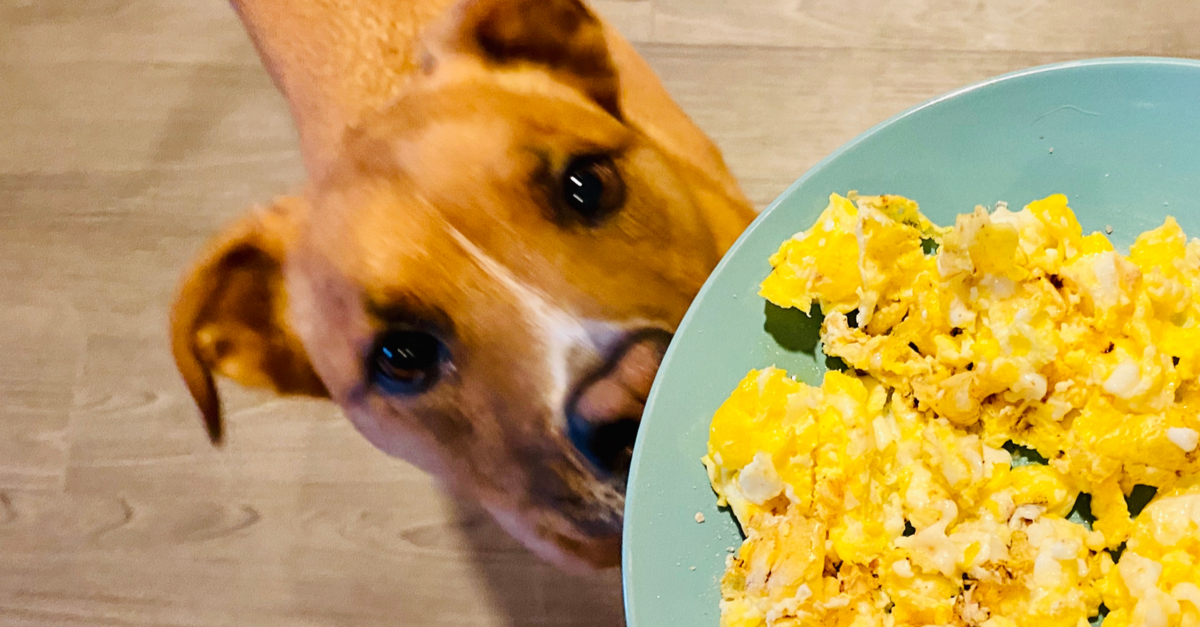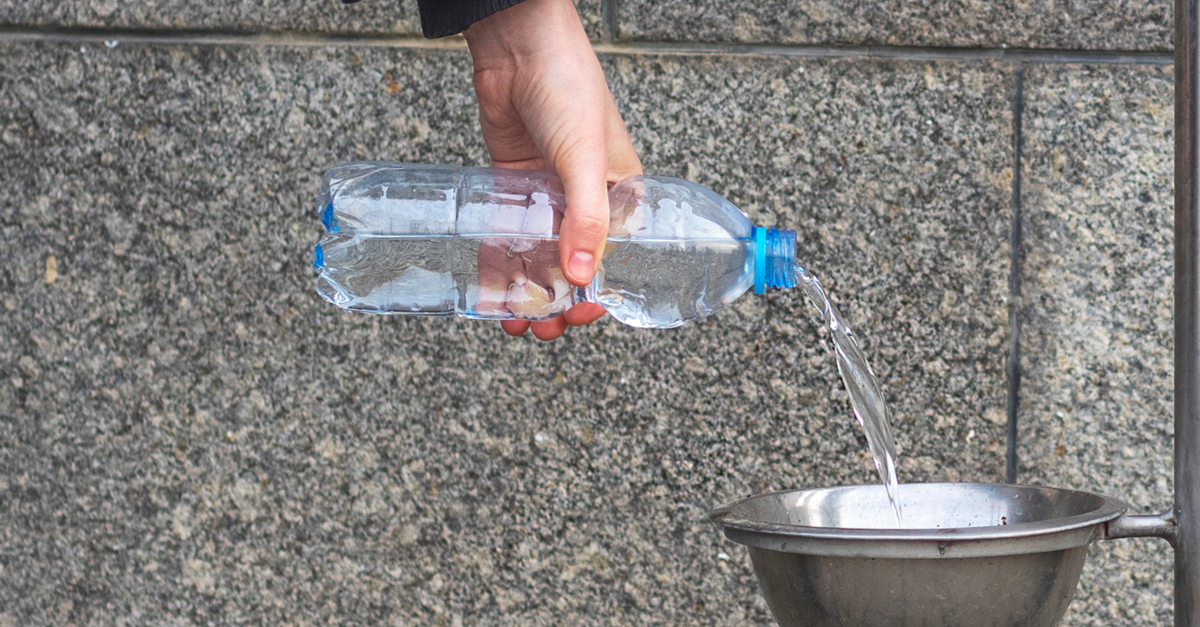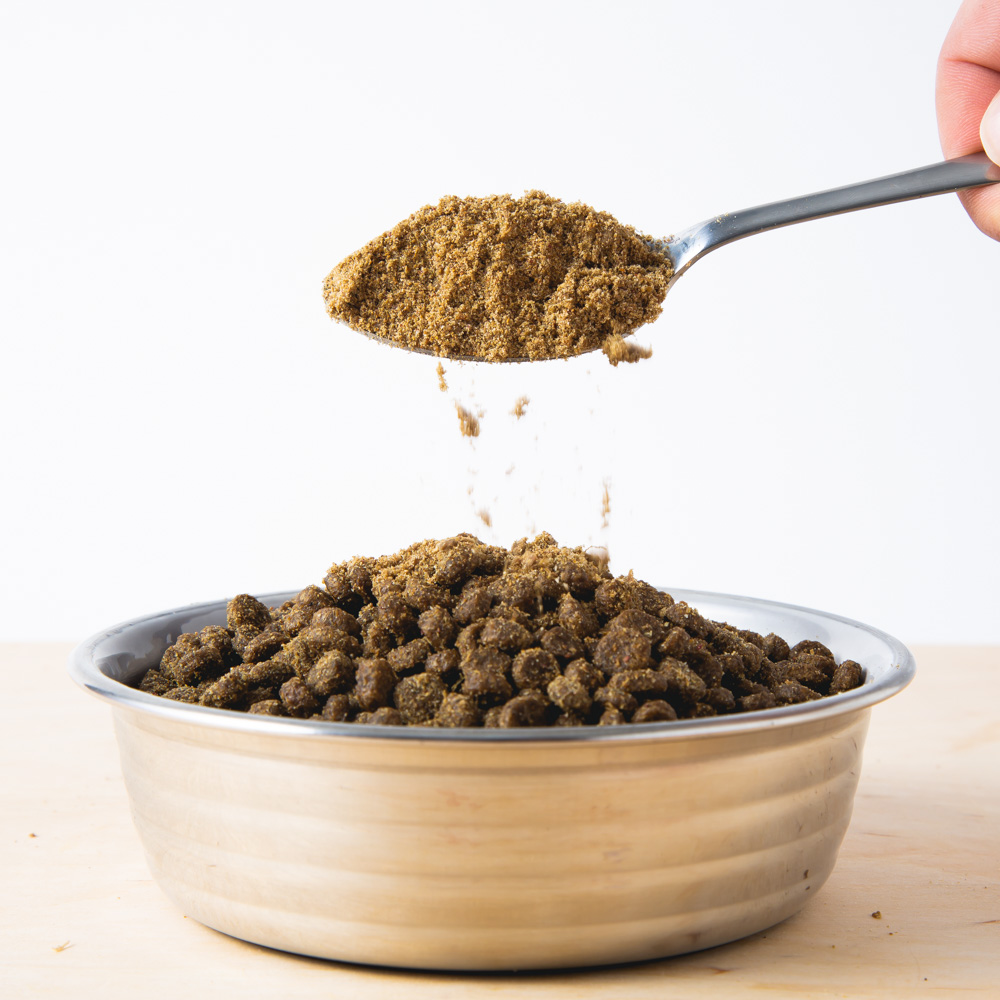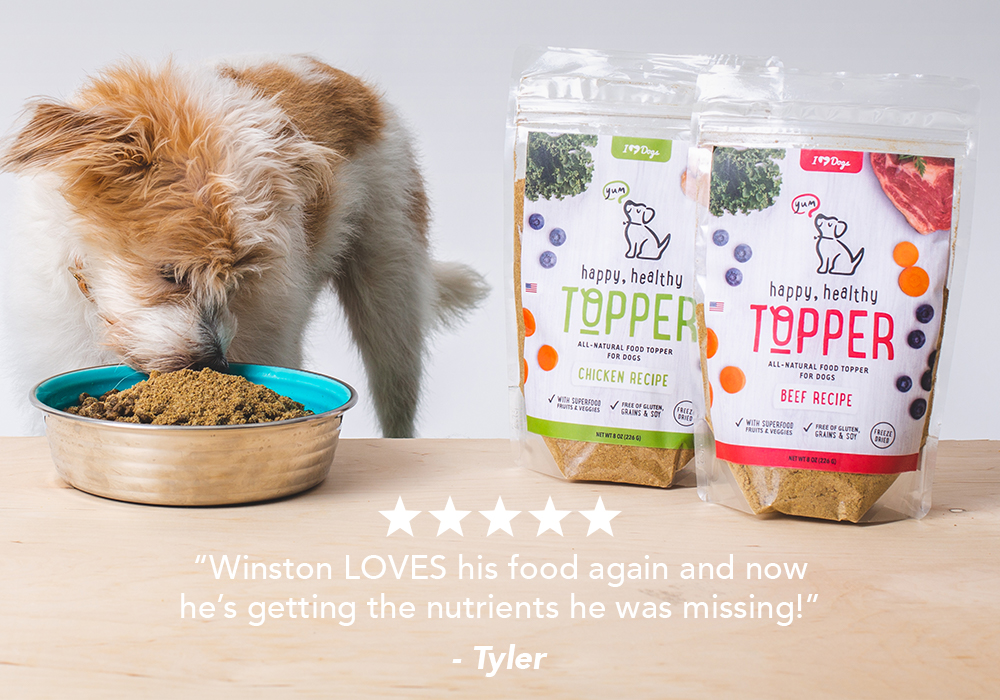All of us want to give our dog’s the best nutrition possible. However, we all have budget limitations. While store bought kibble is very convenient and relatively low priced (compared to canned or fresh diets) it does have several nutritional shortfalls. In this guide, we’ll discuss 5 low cost ways to make any dog food better.
1. Add Sources Of Fresh Protein

Surprisingly, most kibble contains less than 25% protein. That means that most dry foods contain carbohydrates in the neighborhood of 50-60%, despite the fact that dogs have zero biological need for carbs. Carbs are simply low-cost fillers that allow pet food companies to increase their caloric intake without adding substantial cost (real fresh meat is expensive!). For this reason, the single most important way to improve your dog’s diet is by boosting the protein levels.
Avoid meat sources that contain excessive salt or are heavily processed. Our favorite add-ins are:
- Raw or cooked eggs
- Chicken breast
- Ground beef or lamb
- Freeze-dried meat toppers – Unlike processed pet foods, freeze-dried meat leaves intact the nutrients, making it more bioavailable and usable by your dog’s body.
Just remember that fresh meat will add some calories, so you should consider reducing your dog’s kibble by a bit. If you’re interested in switching your dog to fresh food and looking for a good place to start, see our list of the 10 Best Fresh Dog Food Brands.
2. Add A Splash Of Water

Here’s one tip that will cost you nothing! Adding some water to your dog’s bowl will keep them better hydrated. Dogs’ ancestral diet contains significantly more moisture than kibble, which contains almost no water. An added bonus is that adding water enhances the smell and taste of bland, dry food.
Finally, many dog owners find that soaking kibble in a bit of water helps your dog feel full, which could assist in helping your dog lose a few pounds.
Related: 9 Best Dry Dog Foods
3. Add Colorful Freshly Chopped Veggies

Remember this tip: feed your dog the rainbow! Each color of fruits and veggies provides valuable phytonutrients that are not found in kibble due to the heavy heat of cooking and processing.
Our favorites colorful veggies are:
- Broccoli
- Carrots
- Kale
- Bell peppers (rotate green, red, orange, and yellow)
- Green beans
- Celery
- Sweet potatoes (cooked)
- Yellow Squash (cooked)
Remember, your dog gets more value from many colors than from one. So rather than feeding 3 green veggies, keep it colorful with variety.
But wait, what if your dog won’t touch fresh veggies!? If your picky pooch doesn’t tolerate freshly chopped vegetables in their bowl, consider using a freeze-dried mix of meat and veggies, such as the Happy, Health brand.
4. Add Colorful, Cancer Fighting Fruits
Blueberries are our absolute favorite fresh fruit add-on! Many studies have shown that blueberries contain anti-inflammatory and anti-tumor properties due to their high levels of polyphenols and flavonoids.
You can add crush fresh or frozen blueberries over your dog’s kibble or buy a freeze-dried meal topper that already contains blueberries.
Some of our other favorite fruits for dogs are:
- Watermelon
- Apples (minus the seeds)
- Strawberries
- Cantaloupe
- Blackberries
- Raspberries
- Pears
- Bananas
⚠️ Just remember, there are some toxic fruits and veggies you need to avoid. Never give your dog grapes, raisins, tomatoes, and onions.
Related: 11 Best Dog Foods for Allergies
5. Add Freeze Dried Meat Toppers
For many pet owners, it’s not always possible to have fresh meat or freshly chopped fruits and veggies on hand every night. For this reason, freeze-dried toppers have exploded in popularity over the last few years. In fact, they’re one of the fastest-growing products in pet stores today!
Freeze-dried toppers offer substantial benefits over processed kibble because freeze-drying gently locks in nutrients. It’s about as close to fresh as you can get!
Plus, there’s an added benefit of freeze-dried topper: dogs go absolutely crazy at mealtime! We like the Happy, Healthy brand of toppers because it includes chicken or beef, probiotics (help the transition), blueberries, kale, and carrots for additional nutrition.
Related: 9 Best Freeze-Dried Dog Food Brands
Unlike kibble, no heat is used with a freeze-dried product, so the meat is as close to nature as possible. The addition of a small number of fruits and vegetables helps increase your dog’s intake of natural vitamins and valuable phytonutrients that are not found in dry dog food.
When we taste-tested this topper in the iHeartDogs offices, 10 out of 10 dogs went CRAZY for it over their regular kibble. The topper coats your dog’s existing kibble, boosting the flavor and nutrition.
You can learn more about the toppers here.
Need some other ways to boost protein? Add an egg (cooked or raw) over your dog’s kibble, and reduce their portion to account for added calories. You can also serve up some shredded chicken or turkey breast. Just be sure to avoid deli meats with too much added salt or processing.
The best thing you can do for your dog is switch to high-quality, nutritious dog food. See our recommendations for Best Dog Foods and Best Puppy Foods.
These statements have not been evaluated by the Food and Drug Administration. This product is not intended to diagnose, treat, cure, or prevent any disease. The information on this website is not intended to replace a one-on-one relationship with a qualified healthcare professional.
Frequently Asked Questions About Dogs and What They Eat
1. What Is Healthy For Dogs To Eat Everyday?
Ensuring that your dog is on a healthy diet is crucial for their well-being. A balanced diet for dogs must consist of protein, carbohydrates, fats, vitamins, and minerals. While dogs can eat various types of food, it is essential to ensure that their daily diet meets their nutritional requirements. Here are some examples of foods that are generally safe for dogs to consume daily:
- Premium dog food that is designed for your dogs size, weight, and unique dietary needs.
- Lean meats: chicken, turkey, and beef (cooked, unseasoned)
- Vegetables: carrots, green beans, and peas (cooked or raw)
- Fruits: apples, bananas, and blueberries (remove seeds and pits, feed in moderation)
- Whole grains: brown rice, oatmeal, and quinoa
- Dairy: plain, unsweetened yogurt and cheese (in small amounts, monitor tolerance)
- Fish: cooked salmon, tuna, and whitefish (source of omega-3 fatty acids)
2. What Is The Healthiest Way To Feed A Dog?
The healthiest way to feed a dog involves providing a well-balanced diet that meets their nutritional requirements and suits their individual needs. Here are some tips for maintaining your dog’s health:
- Quality nutrition: Choose a high-quality dog food or a homemade diet that balances protein, carbohydrates, fats, vitamins, and minerals.
- Portion control: Measure your dog’s food portions according to their specific needs, considering their age, size, activity level, and any existing health conditions to prevent overfeeding or underfeeding.
- Regular feeding schedule: Establish a consistent feeding routine, providing meals at the same times each day to help regulate their digestion and prevent unnecessary snacking.
- Access to water: Ensure your dog has constant access to clean water to stay hydrated throughout the day.
- Regular exercise: Combine a healthy diet with regular exercise to maintain your dog’s physical and mental well-being, promoting muscle strength, joint health, and overall stamina.
3. Can I Feed My Dog Homemade Dog Food Everyday?
Feeding your furry friend homemade meals can be a great way to ensure they eat all-natural and dog-safe ingredients! Like us, our dogs thrive on a well-balanced diet with many tasty and nutritious ingredients. Here are some tips to ensure your pup gets the best out of their homemade meals:
- Balanced nutrition: Create a mix of wholesome ingredients, such as lean meats, whole grains, and veggies, to give your pup a yummy and healthy diet.
- Fresh is best: Opt for fresh, high-quality ingredients free from harmful additives. In addition, when cooking with meat, make sure the meat is cooked thoroughly to eliminate the risk of bacteria contamination.
- Supplements: Depending on your dogs’ needs, your vet might recommend specific supplements to ensure your dog gets the nutrients needed to live a healthy lifestyle.
4. What Veggies Can I Add To My Dogs Food?
Adding vegetables to your dog’s meals can be a great way to provide essential vitamins and minerals. Several dog-friendly vegetables include:
- Carrots: Carrots are a nutritious and delicious snack for dogs, packed with vitamins, high in fiber, and low in calories.
- Green beans: These vegetables are a great source of vitamins and minerals and can be eaten raw, steamed, or boiled.
- Peas: Peas are a nutritious addition to your dog’s diet, rich in essential nutrients such as potassium and vitamin A.
- Pumpkin: A can of plain pumpkin (not pie filling) can help dogs’ digestion with fiber and beta-carotene.
- Spinach: It’s a nutrient-dense vegetable that provides vitamins A, B, C, K, iron, and antioxidants.
- Sweet potatoes: These can be cooked, mashed, or pureed and are a great source of dietary fiber, vitamins, and minerals.
Remember to introduce new vegetables gradually to monitor how your dog reacts to them. Some dogs may have specific dietary sensitivities or allergies. Watch for any adverse reactions when introducing new foods to your pup. If your dog is prone to allergies check out best food for dog allergies for some ideas for your pup. If you notice any digestive upset or allergic reactions after introducing new foods, consult your veterinarian.
5. Is Sweet Potato Good For Dogs?
Sweet potatoes are packed with vitamins and fiber, which boost a healthy immune system and digestion, making them a great energy boost, especially for active dogs. The safest and most effective way to serve them to dogs is coked plain without any added spices or seasonings, as those can harm your pup.
Always gradually introduce new foods to check for adverse food reactions or allergies.
6. Do I Need To Add Anything To Homemade Dog Food?
Dog food toppers can be a real game-changer to add to your homemade meals! They offer an easy way to encourage your pup’s nutrition by adding vitamins and supplements, all while bringing some tasty variety to their bowl. With options tailored to specific health needs, they can make mealtime more exciting and help keep your furry friend feeling their best.
7. What Not To Put In Homemade Dog Food?
Being able to control which ingredients are in your dogs food is an excellent way to ensure your dog receives all the nutrients it needs and none of the harsh chemicals or preservatives store bought food can carry. While fresh ingredients is best, not all ingredients at home are safe for your four legged family member. Here are some foods to avoid:
- Onions and Garlic: These foods can have a negative effect to a dogs red blood cells which may lead to anemia.
- Grapes and Raisins: It’s no secret that grapes can be toxic to dogs as it is a common toxin. However, grapes in any form are not safe, including raisins.
- Chocolate: Chocolate is a tasty treat for humans but, not for dogs. Chocolate contains atheobramine which can lead to heart issues and in some instances can lead to death.
- Artificial Sweeteners: Artificial sweeteners may contain a chemical called Xylitol. Artificial sweeteners are often used in sugar-free products to add sweetness to food. However, if ingested by dogs, it may cause a rapid drop in blood sugar and iliver failure.
- Avocados: Avocados contain persin. Persin is a toxic ingredient that may cause vomiting and diarrhea in dogs.
- Sodium: Foods that contain large amounts of salt can lead to dehydration and excessive thirst. In extreme instances it may cause sodium ion poisioning.
Nervous to be your dogs chef? Check out Best dry dog food for a list of delicious and pet approved dry foods.
If you are wondering if the food ingredients in your dogs fresh food is good for them, consult an veterinarian.
8. What Can I Make For My Dog When Out Of Dog Food?
If you run out of your dog’s regular food, there are many safe and healthy options you can prepare at home with common household ingredients. Some simple homemade meals for your dog could include:
- Cooked rice and boiled chicken: This is a gentle and easily digestible option for dogs. Ensure the chicken is boneless and the rice plain without adding seasonings or salt. This is also a great option for those pups with sensitive stomachs as it is easy to digest.
- Scrambled eggs: Eggs are a great source of protein that most dogs love. Ensure to cook them plain without adding salt, butter, or oil.
- Canned fish: Canned fish such as tuna or salmon are a quick and convenient source of protein and healthy fats.
- Cooked ground beef or turkey: Lean ground beef or turkey, cooked thoroughly without added spices or ingredients.
- Plain yogurt: Plain, unsweetened yogurt can be a healthy and soothing treat for your dog’s stomach, as it contains probiotics that can help digestion.
It’s important to avoid any foods that may be harmful to dogs.
9. What Can I Add To My Dogs Food To Fill Him Up?
If you’re trying to fill up your pup’s belly a bit more, there are some fantastic options you can toss in with their food. How about some green beans or carrots for that extra crunch? Canned pumpkin (not the pie-filling kind) is a great way to add some bulk without piling on the calories. Boiled chicken or turkey could satisfy them without making them too heavy. Is your dog not getting full because he/she is a picky eater? Try dog food toppers. Dog food toppers add nutrients to their food and makes dry kibble more appealing.
Check out some best selling dog food toppers. Just remember to take it slow with any changes to their diet!





 Toledo, United States.
Toledo, United States.